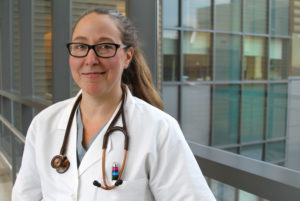- Pollution and Patient Safety: Balancing Saving Lives With Protecting Public Health
- 9:15-10:15 a.m. Wednesday
- West, Room 2020
When we think of pollution, we envision plastic drink bottles, plant and auto emissions, and landfills churning with consumer waste. Yet health care is a top contributor to pollution in the world – and unfortunately, anesthesiology is a contributor as well.
Manufacturing, use, and disposal of waste from inhaled anesthetics and injectable drugs are concerning pollutants, as are toxins stemming from scrapped O.R. instruments and equipment, according to Jodi Sherman, M.D., Associate Professor of Anesthesiology and Epidemiology in Environmental Health Sciences and Director of Sustainability (Anesthesia) at Yale New Haven Hospital. Dr. Sherman leads Wednesday’s session, “Pollution and Patient Safety: Balancing Saving Lives With Protecting Public Health.”

Jodi Sherman, M.D., says anesthesiologists are often trained in a “candy store” culture of waste.
“Anesthesiologists are trained in a ‘candy store’ culture. We have virtually unlimited access to supplies and think it’s normal to use and waste lots of stuff,” Dr. Sherman said. “Even in the midst of a drug shortage crisis since Hurricane Maria devastated Puerto Rico, where significant quantities of U.S. drugs are manufactured, we are still wasting large quantities of drugs.”
Despite the great strides modern medicine has made in patient care, the tools of the trade are harming the planet and its inhabitants. Many of the things anesthesiologists use come from and eventually find their way back to the environment, but largely in synthetic form or in large quantities that ecosystems have not evolved to handle. Inhaled anesthetics produce greenhouse gasses that are vented off hospital rooftops. Injectable drugs and their metabolites make their way through manufacturing and treatment plants and sewage systems not designed to remove them.
“Plastic packaging and supplies never really biodegrade, and they are laden with chemicals that impart desirable properties like pliability or rigidity,” Dr. Sherman said. “These chemicals are notable hormone disruptors. When plastic is burned, pollutants are liberated, including dioxins that are potent carcinogens and heavy metals, which are potent neurotoxicants.”
Metals require energy to mine and manufacture, while electronics often are cast aside with a “single use” mentality, she said. Wednesday’s session will describe pollution-related human health impacts, as recognized by the World Health Organization, explain anesthesia-related public health risks from pollution due to O.R. equipment, supply and pharmaceutical management choices and identify opportunities for anesthetic practice improvements that mitigate pollution and climate change without compromising patient care.
“Clinical recycling is possible. However, it requires tremendous vigilance to protect against accidental cross contamination with potentially infectious material,” Dr. Sherman said. “What is recyclable from clinical waste depends on your recycling vendor and what they are willing to accept. They might ask that your facility decontaminate the tongue blades first, which requires additional infrastructure. This requires an institutional commitment and is a significant barrier to recycling.”
Consider the “ick factor,” too, she said.
“If something appears it could potentially be infectious, it can be scary to hospital recycling vendors. You may drop a clean syringe on the floor and think it is safe to recycle. However, the vendor has no way of knowing whether it is clean or dirty. Syringes are classified as sharps. Throwing a clean one in the recycling bin has shut down clinical recycling programs.”
The most important message is to waste less. Use the lowest fresh gas flow rates possible, better predict what supplies are necessary to prepare for a case and don’t open them unless they are needed. Pre-filled syringes can reduce waste and help with the current shortage of injectable drugs, she said.
Return to Archive Index
